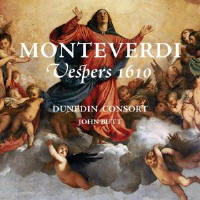Texte paru dans: / Appeared in: |
|
|
Outil de traduction ~ (Très approximatif) |
|
|
Reviewer: J.
F. Weber The Dunedin Consort consists of 14 instrumentalists, joined here by the six players of His Majestys Sagbutts & Cornetts and 10 vocal soloists. The recording follows the contents of the 1610 publication (omitting the extra Magnificat a6), adding nothing, rearranging nothing, using Clifford Bartlett’s edition. Hence it competes directly with Wolfgang Katschner (Fanfare 38:4), Christina Pluhar (35:1), Sigiswald Kuijken on Challenge, Rinaldo Alessandrini (28:4), Stephen Stubbs on Atma, Konrad Junghänel (20:2), and David van Asch (19:4). A list of recordings using one voice to a part should add Paul McCreesh (30:5), but as a liturgical reconstruction it belongs in a different category. Andrew Parrott (8:6; CD in 9:2) was the first to perform some movements with one voice to a part, but others were given to the consort. Among 68 recordings of the Vespro (by my count), this means that most versions of the work use larger ensembles. (In fact, Butt’s 20 players is a slightly larger group than any of the seven directly competitive versions.) Butt chooses a high pitch (a’=466), as others have also done, and follows the transposition of the fifth psalm and the canticle down a fourth, as often practiced since Jeffrey Kurtzman proposed that chiavette in those two movements require transposition. Tenor Nicholas Mulroy is superb in Nigra sum, as are sopranos Joanne Lunn and Esther Brazil in Pulchra es and the Sonata sopra Sancta Maria. The touchstone of any Vespro is the fiendishly difficult Duo Seraphim for three tenors, and here Matthew Long, Joshua Ellicott, and Mulroy match the best alternatives going back as far as Philip Pickett (14:6). The echo effects in the Magnificat are effective from a surround-sound system. The closest competition to this comes from Rinaldo Alessandrini (28:4), who has a distinct advantage in including the six-voice Magnificat, a sensible way to add to the short timing of the two discs and make the Vespro truly complete. He assigns the Sonata to a single soprano. In that review I mistakenly referred to Parrott and Pickett as competitive single-voice versions, whereas both include choral voices selectively.
Clearly
most of the many remaining versions of this masterwork fall into two broad
categories: solo and choral voices with larger orchestral forces or
liturgical reconstructions. The latter range from simply adding six chant
antiphons to the inclusion of all the sung texts of a Vespers; they may
rearrange the order of movements and add pieces by other composers. These
have been discussed at length here, but the precise competition for the
simple single-voice approach may be reduced to Butt and Alessandrini. One or
the other should find a place in every collection of Baroque sacred music.
| |
|
Support us financially by purchasing this disc from eiher one of these suppliers. Un achat via l'un ou l'autre des fournisseurs proposés contribue à défrayer les coûts d'exploitation de ce site. |
|
|
|
|
|
Cliquez l'un ou l'autre
bouton pour découvrir bien d'autres critiques de CD |
|




